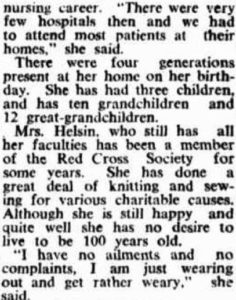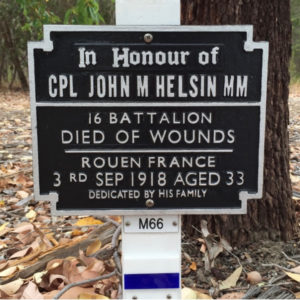
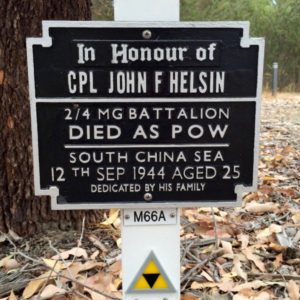 Father and son, casualties of WW1 and WW2 are together remembered at Kings Park Avenue of Honour.
Father and son, casualties of WW1 and WW2 are together remembered at Kings Park Avenue of Honour.

WX10095 John Frederick Helsin was born London 3 April 1919. He was the son of Australian born John Malmo Helsin and English born Edith Emily Field who married during WW1 London. Son and father never had the opportunity to meet.
Earlier during the war, John Malmo had been awarded a Military Medal whilst serving in France.
John Malmo Helsin who was with Australia’s 16th Battalion, died in France on 3 Sep 1918. He was born in Melbourne, Victoria. His Swedish father had come from Malmo and it was his wish for his son to remember their family roots. John Malmo’s mother Elizabeth Ann Helsin was widowed young and moved from Melbourne to Western Australia with her only son and two daughters. John Malmo was educated at Cottesloe.
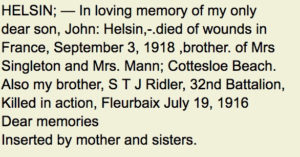
Widow Elizabeth Helsin lost her only son and her brother during WW1.
She would later mourn the loss of her grandson John Frederick Helsin who lost his life in WW2.
Nurse Helsin
Widow Elizabeth Ann Helsin (nee Ridley) became a highly regarded midwife around Cottesloe. There were no maternity hospitals then – babies were delivered by midwives (sometimes neighbours/relatives).
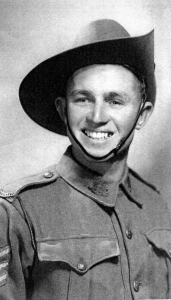
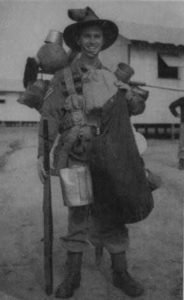
At the age of 6 months John Frederick Helsin sailed to Fremantle from London in Sept. 1919 with his widowed mother Edith Emily Helsin (nee Field) and 2 year old sister Dorothy Mabel known as ‘Molly’. The small family would have been much welcomed by Elizabeth Helsin, mother of John Malmo.
Edith Helsin would later remarry.
Their grandmother, Nurse Helsin was part of their small family unit.
John Helsin WX10095 enlisted December 1940 and joined ‘B’ Company. Following the capitulation by the Allies to Japan and the Australian 8th Division became POWs, mostly at Selarang Camp. Corporal Helsin was selected to work on the Burma end of the Thai-Burma Railway with ‘A’ Force Burma, Green Force No. 3 Battalion. Please read further about this Force.
3,000 POWs sailed from Singapore on 14 May 1942 for South West Burma, with Green Force stopping at Victoria Point to repair and enlarge the aerodrome before heading to the beginning of railway in Burma, the first work camp being Kendau 4.8 km.
By the end of 1943 the railway was completed, the Japanese began moving the POWs from Burma by railway – the track the POWs had been building for past 12 months, to one of several large camps in Burma. Those too ill to be transported, remained behind with medical staff, and waited to die.
In Dec 1943, some mail and messages from POWs successfully arrived from Thailand. Edith would have had her hopes raised, she was one the fortunate, most mail did not leave Thailand let alone arrive in Australia.
During May through to Dec 1943 John was evacuated sick from Aungganaung 105 Km Camp to Khonkan Hospital. We have no details of his illness or dates however he must have recovered sufficiently to be sent by trains south to Thailand and may well have arrived at Tamuang Camp, from where most POWs selected for Japan were accommodated.
He was selected for what would become known as ‘Rakuyo Maru’ Party. The Party was first sent by train via Bangkok to French Indo-China with Saigon as their destination. It was intended the POWs would be shipped to Japan from here. While they waited in Saigon the POWs worked at the wharves and other nearby projects, several times attempted to make their way to their intended ship but were returned to their Saigon accommodation.
Finally after many weeks, the Japanese decided the American submarine blockade had become too successful, the waters were filling with sunken Japanese ships.
The ‘Rakuyo Maru’ Party was then advised they were being returned by train to Singapore, via Bangkok. In Singapore they were accommodated at River Valley Road Transit Camp to wait for a ship. POWs worked again at the wharves and other locations around the island before finally boarding their ship ‘Rakuyo Maru’ and sailing out of Singapore about 9 Sep 1944.
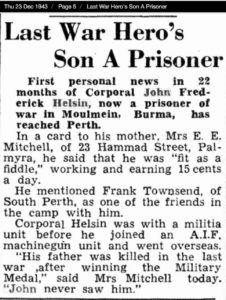
The ‘Rakuyo Maru’ which was transporting POWs from Singapore to Japan was sunk 12 Sep 1944 in the South China Sea by an American submarine – part of a ‘Wolf Pack’ which successfully sank several ships in the convoy. Although it was 12 hours before the ship sank, the worst was to follow. Hundreds of POWs were now in the water, covered in oil, some with injuries. None of these young POWs had begun their journey in good health. They scrambled for floating devices as the Japanese crew were picked up by their own ships. Some POWs re-boarded the ‘Rakyuyo Maru’ before it sank, looking for water and food. For most men – they had nothing. Thirst was their greatest challenge. The men remained in the water for several nights and days and each morning their mates would count the lose of mates who had fallen asleep and disappeared quietly in the night’s darkness. Some went mad having drunk sea water, several endangered others in their madness. By some miracle, a very small number of POWs were alive when the American submarines returned to the battle scene. They couldn’t believe what they saw!
John was one of hundreds of POWs who perished during those terrible days following the sinking of their ship. He was 25 years old.
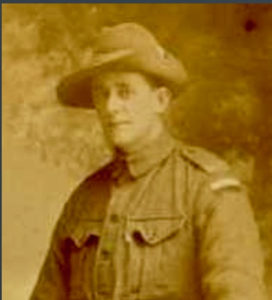
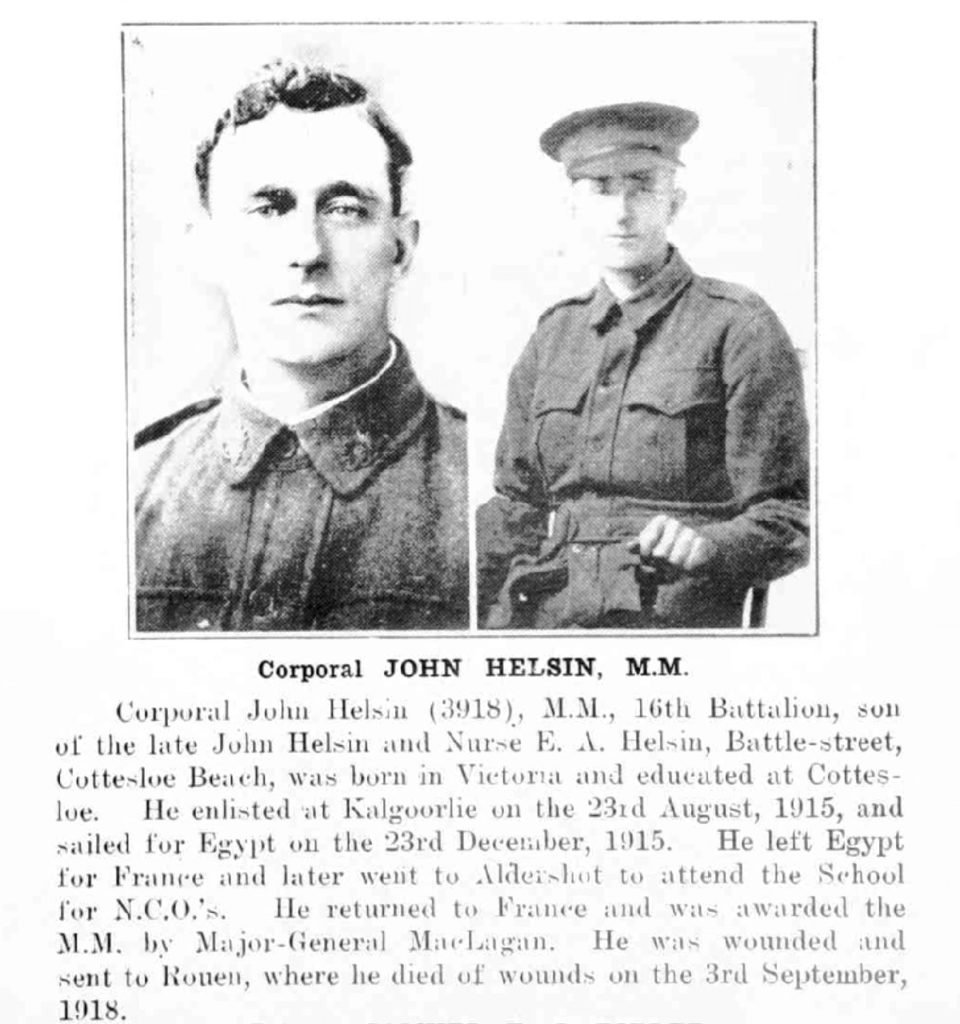

John’s grandmother Elizabeth Helsin, aka Nurse Helsin celebrated her 92nd birthday in 1949. She arrived in WA in early 1900’s as a young widow with 3 young children, lived through WW1 – the death of her only son John Malmo Helsin and live through WW2 and learn of the death of her son’s son and her grandson John Frederick Helsin WX10095 who perished in South China Sea in Sep. 1944 at the age of 25 years.
